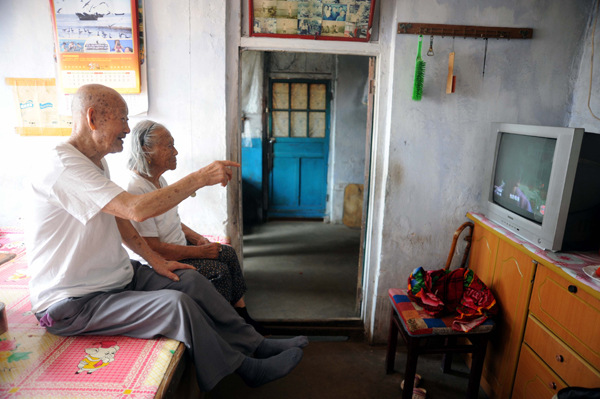Will the idiot box get smarter
 |
|
Farmer Gong Deyun and his wife Sun Yucui watching TV at their home in Gongjia village, Rushan of Shandong province, in this file photo dated last Aug 21. Liu Guoxian / for China Daily |
"This uniformity has driven away many viewers, especially the young ones who like pursuing freedom," Song says. "Youngsters like to grasp the initiative and do not want to be led by the nose Compared with the fixed TV programs, video apps and the Internet give people more options. Without any time limit, I can watch any program I like whenever I want."
Young people are abandoning the habit of watching TV at home, for most of the series are telecast between 8 pm and 10 pm when it's time for them to meet friends or have supper.
"I know that some TV stations want to make their programs more innovative, but that will take time," Song says. "Given the current audience-rating competition mechanism, few of them have the courage to take the risk. Instead, they would rather buy or even copy some shows or TV series from abroad or other domestic channels.
"Without innovation and finding other profit models, it will be really difficult for TV channels to win back viewers," he says. "In the United States, premium channels have developed a good profit model under which people can order their favorite TV programs after paying a certain amount of money."
Social circumstances have forced people to choose other video channels to access programs broadcast in the past, says Leng Song, secretary of World Media Research Center, affiliated to the Chinese Academy of Social Sciences. "An increasing number of people are trying to access certain episodes of some programs they missed but which have sparked a debate that they want to be part of. What they want sometimes is just a small fragment of a program."
Smart TV manufacturers have been trying to come up with new technology and design to provide better audio-visual effects for viewers, but the feedback has not been that promising.
According to a China Electronics Chamber of Commerce survey, the penetrating rate of smart TV sets in the Chinese market was nearly 40 percent at the end of last year. The figure is estimated to reach 50 percent this year, that is to say, smart TV will account for about 60 percent of the about 450 million TV sets in the country.
Another survey conducted by the chamber shows the average age of people who watch TV regularly is 40 years and above, with experts saying the age would be higher in the following years. This is likely to contract the TV set market further.
Most Chinese homes with smart TVs need at least three remote controls - one for the TV set, another for set-top box and a third for auxiliary gadgets like DVD players. But the remote control of a smart TV set alone has between 70 and 80 buttons. "It is very confusing and complicated for people of my age," says Ren, the song-and-dance duet fan. "I can recognize only a few buttons like the 'on' and 'off' ones and those meant to change channels and the volume."
Computers and mobile phones are preferred by the younger generation for their "convenience", Leng says. "In terms of technology, I think it will take at least 10 years for TV sets to come up with other mobile broadcast channels."
"Take iPad for example. It has only one button and my 90-year-old father as well as 4-year-old son both can handle it easily," Leng says. "But a smart TV, with two or three remote controls, is very complicated. Without carefully reading the instruction, it will take you a long time to find what you want."
"So to attract more customers, TV manufacturers have to be innovative with their products," says Chen Bingfeng, marketing manager of TCL, China's leading television and mobile phone maker. Many smart TV owners have not been able to use all the high-tech functions, Chen says. And only if after-sales service is improved and ancillary devices are made user-friendly will people feel attracted to smart TVs. "The industry's chain is big and cannot be built by just the TV set manufacturer it also needs the help of software designers, auxiliary device makers and, above all, customers," Chen says.
A smart TV has to be simple to operate to attract buyers, according to a market survey conducted by Hisense, a leading Chinese TV manufacturer. Trying to meet this requirement, Hisense has created a new model with only 28 buttons on its remote control, which hit the market on April 17. Also, it takes only 0.1 second to switch on the TV with the remote control.
It seems, TV viewers have to be content with such changes till a really smart TV set that could be controlled by voice or the eyes hits the market, says Zhou Houjian, chairman of Hisense.
Related:
|
|
|
| Playing the game | Trading places |


















